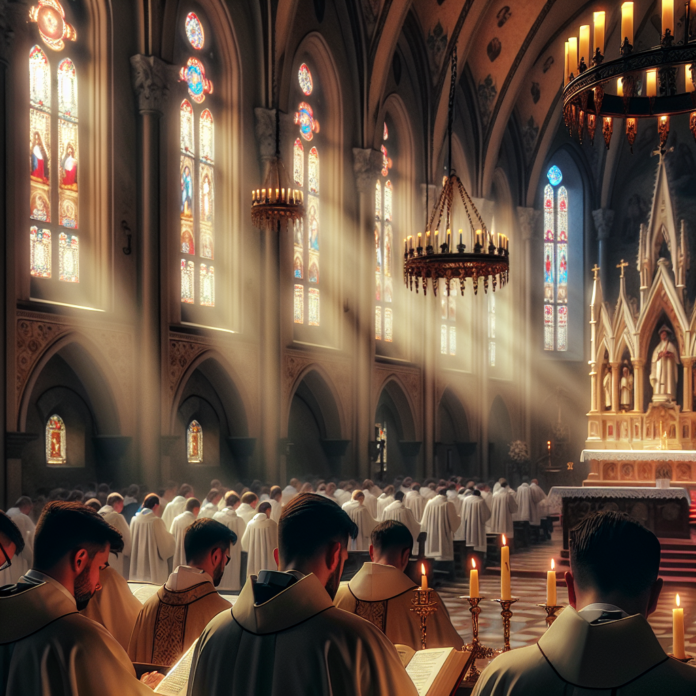The Tridentine Mass: Reverence or Rigidity?
The Catholic Church, as an institution, is historically rich, deeply rooted in tradition, and influential in shaping cultures and societies worldwide. Yet, it finds itself in a continual tug-of-war between tradition and modernization. A key battleground in this ideological struggle has been the liturgy, particularly the Tridentine Mass, often viewed as a symbol of reverence by its advocates and rigidity by its critics. Understanding the nuances of this debate requires a dive into the past, an examination of the cultural undercurrents that have shaped liturgical practices, and a consideration of the Church’s role in a rapidly evolving world.
The Tridentine Mass, also known as the Traditional Latin Mass, traces its origins to the 16th century. It was codified by the Council of Trent in 1570 in an era marked by the Protestant Reformation and a Catholic need for unity and uniformity. This version of the Mass was celebrated in Latin and followed a strict rubric, leaving little room for variation. For centuries, this rite dominated Catholic worship, serving as both spiritual sustenance and a formidable tool of ecclesiastical authority.
However, the mid-20th century witnessed seismic shifts in the Church’s approach to worship. The Second Vatican Council (1962-1965), initiated under the papacy of John XXIII, sought to make the Church more accessible and relevant to contemporary society. This Council proposed a liturgical reform aimed at fostering active participation among the faithful. As a result, the Mass was translated into vernacular languages, symbolic distances between clergy and congregation were reduced, and a more inclusive and dynamic engagement became encouraged. This reform, known as the Novus Ordo Mass, stood as a testament to the Church’s willingness to adapt to modernity.
Despite the broad acceptance and implementation of the Novus Ordo, the Tridentine Mass never vanished. In 2007, Pope Benedict XVI promulgated the motu proprio Summorum Pontificum, which made it easier for priests to celebrate the Traditional Latin Mass, leading to a resurgence in its practice. For many traditionalists, the Tridentine Mass is the epitome of sacredness and continuity. Yet, it raises questions about inclusivity and relevance in contemporary worship.
Detractors view the Tridentine Mass as emblematic of an inflexible tradition resistant to change. The Mass, conducted solely in Latin, remains inaccessible to many of the faithful, creating an alienating divide. In an era that prizes transparency and engagement, the Tridentine Mass may be perceived as an opaque relic of a bygone time, adhering more to rubrics than to genuine spirituality. The silent, often passive congregation can feel disconnected from its core message. Moreover, the cultural trappings associated with its celebration often evoke a sense of exclusivity rather than the universality that the Church aspires to embody.
Indeed, proponents of progressive values argue that the Church should reflect the dynamism of today’s world, embracing diversity, dialogue, and openness. This perspective is not merely aesthetic but carries significant implications for the Church’s mission. When worship is inclusive and participatory, it resonates with the broader community, inviting engagement and fostering a deeper spiritual connection. In contrast, liturgical rigidity may stunt this openness, causing the Church to appear anachronistic to modern believers.
Furthermore, a tendency towards conservatism within sectors of the Church can contribute to cultural isolation. This adherence to traditional norms often extends beyond the liturgy, influencing views on social issues, interfaith dialogue, and communal inclusivity. Although tradition provides a foundation of continuity and identity, clinging rigidly to the past may impede the Church’s ability to minister effectively to contemporary realities.
The historical context of the Tridentine Mass is undeniably significant, reflecting a paradigm instituted during crucial reformative times. Yet, as we move further into the 21st century, the challenge is to discern which aspects of tradition serve as vital anchors and which may inadvertently constrain growth and outreach. The Church must navigate these waters carefully, balancing respect for its history with a progressive, forward-thinking approach.
Finding this balance is crucial not only within the context of liturgy but also in addressing global issues. As societal values evolve, so must the Church, if it aims to remain relevant and nurturing for all its members. Flexibility and openness, coupled with a genuine commitment to dialogue, can pave the way for a vibrant, welcoming, and spiritually fulfilling community.
In conclusion, while the reverence associated with the Tridentine Mass holds profound meaning for many, it is imperative for the Church as a whole to transcend rigidity. Embracing a liturgical practice that honors tradition yet remains accessible to a diverse congregation will help ensure that the timeless message of faith resonates clearly and compassionately in today’s world. Ultimately, the vibrancy of any faith community depends on its ability to reflect the complexities and aspirations of its adherents, forging a path that is as inclusive and dynamic as it is grounded in enduring truths.
